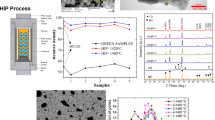Abstract
Sintering is performed for the pure α-cristobalite, with TiO2 additive, and with CaO additive powder compacts. The sintering temperatures were 1500, 1515, and 1525 °C for different dwell times. The master sintering curve theory is applied to the densification data and the activation energies are obtained. The splitting strength is measured for the sintered specimens. It is found that CaO decreases the activation energy due to the formation of liquid phase at the used sintering temperatures. The TiO2 increases the activation energy because it exists as solid particles at the used sintering temperatures. The measured splitting strengths of the sintered specimens are shown to be best expressed by a sigmoid function of the work of sintering.




Similar content being viewed by others
References
Boch P, Leriche A (2007) Sintering and microstructure of ceramics. In: Boch P, Niepce J (eds) Ceramic materials processes, properties and applications. ISTE, Eugene
Lakshmanan A (2012) Sintering of ceramics: new emerging techniques. InTech, Rijeka
Ertuğ B (2013) Sintering applications. InTech, Rijeka
Rice RW (2003) Ceramic fabrication technology, Chap. 5. Marcel Dekker Inc, New York
Reiterer MW, Ewsuk KG (2009) An analysis of four different approaches to predict and control sintering. J Am Ceram Soc 92(7):1419–1427
Hunghai Su, Lynn Johnson D (1996) Master sintering curve: a practical approach to sintering. J Am Ceram Soc 79(12):3211–3217
Johnson DL (2003) Finding and utilizing the master sintering curve. Presented at the 3rd International Conference on Science, Technology and Applications of Sintering, State College, PA
Kiani S, Panw J, Yeomans JA (2006) A new scheme of finding the master sintering curve. J Am Ceram Soc 89(11):3393–3396
Shao Y, Hao S, Luo Y, Xing J, Liu Z (2012) An overview of master sintering curve. Appl Mech Mater 174–177:608–613
Blaine DC, Park S, German RM (2009) Linearization of master sintering curve. J Am Ceram Soc 92(7):1403–1409
Tatami J, Suzuki Y, Wakihara T, Meguro T, Komeya K (2006) Control of shrinkage during sintering of alumina ceramics based on master sintering curve theory. Key Eng Mater 317–318:11–14
Shao W, Chen S, Li D, Qi P, Wan Y, Zhang Y (2008) On the sintering activation energy of α-Al2O3. Key Eng Mater 368–372:686–687
Shao WQ, Chen SO, Li D, Cao HS, Zhang YC, Zhang SS (2008) Prediction of densification and microstructure evolution for α-Al2O3 during pressureless sintering at low heating rates based on the master sintering curve theory. Sci Sinter 40:251–261
Shao WQ, Chena SO, Li D, Cao HS, Zhang YC, Zhang SS (2009) Prediction and control of microstructure evolution for sub-microscale α-Al2O3 during low-heating-rate sintering based on the master sintering curve theory. J Eur Ceram Soc 29:201–204
Hilli N, Goeuriot P (2009) Sintering of monodoped and mixtures of monodoped alpha alumina powders. Powder Technol 190:129–133
Shao W, Chen S, Li D, Cao H, Zhang S (2009) Construction of the master sintering curve for submicron size α-Al2O3 based on non-isothermal sintering containing lower heating rates only. Mater Sci Technol 27(1):97–107
Pouchly V, Maca K (2009) Master sintering curves of two different alumina powder compacts. Proc Appl Ceram 3(4):1–4
Rajeswari K, Padhi S, Reddy ARS, Roy J, Das D (2013) Studies on sintering kinetics and correlation with the sinterability of 8Y zirconia ceramics based on the dilatometric shrinkage curves. Ceram Int 39:4985–4990
Mazaheri M, Simchi A, Dourandish M, Golestani-Fard F (2009) Master sintering curves of a nanoscale 3Y-TZP powder compacts. Ceram Int 35:547–554
Pouchly V, Maca K (2010) Master sintering curve: a practical approach to its construction. Sci Sinter 42:25–32
McCoy TM (2008) Extension of the master sintering curve for constant heating rate modeling. PhD Dissertation, School of Materials Science and Engineering-Georgia Institute of Technology, USA
Song X, Lu J, Zhang T (2011) Two-stage master sintering curve approach to sintering kinetics of undoped and Al2O3-doped 8 mol% yttria-stabilized cubic zirconia. J Am Ceram Soc 94(4):1053–1059
Pouchly V, Maca K, Shen Z (2013) Two-stage master sintering curve applied to two-step sintering of oxide ceramics. J Eur Ceram Soc 33:2275–2283
The American Society for Testing and Materials (2005) ASTM designation C0373-88 R99 Standard test method for water absorption, bulk density, apparent porosity, and apparent specific gravity of fired white-ware products
The American Society for Testing and Materials (2005) ASTM designation: C1006-84 R2001 Standard Test Method for Splitting Tensile Strength of Masonry Units
Pelton AD (2001) Thermodynamics and phase diagrams of materials. In: Kostorz G (ed) Phase transformations in materials. Wiley, Weinheim
Ricker RW, Hummel FA (1951) Reactions in the system TiO2–SiO2: revision of the phase diagram. J Am Ceram Soc 34(9):271–279
Author information
Authors and Affiliations
Corresponding author
Electronic supplementary material
Below is the link to the electronic supplementary material.
Rights and permissions
About this article
Cite this article
Farid, S.B.H. Effect of additives on sintering of α-cristobalite. J Mater Sci 49, 4133–4138 (2014). https://doi.org/10.1007/s10853-014-8108-4
Received:
Accepted:
Published:
Issue Date:
DOI: https://doi.org/10.1007/s10853-014-8108-4




